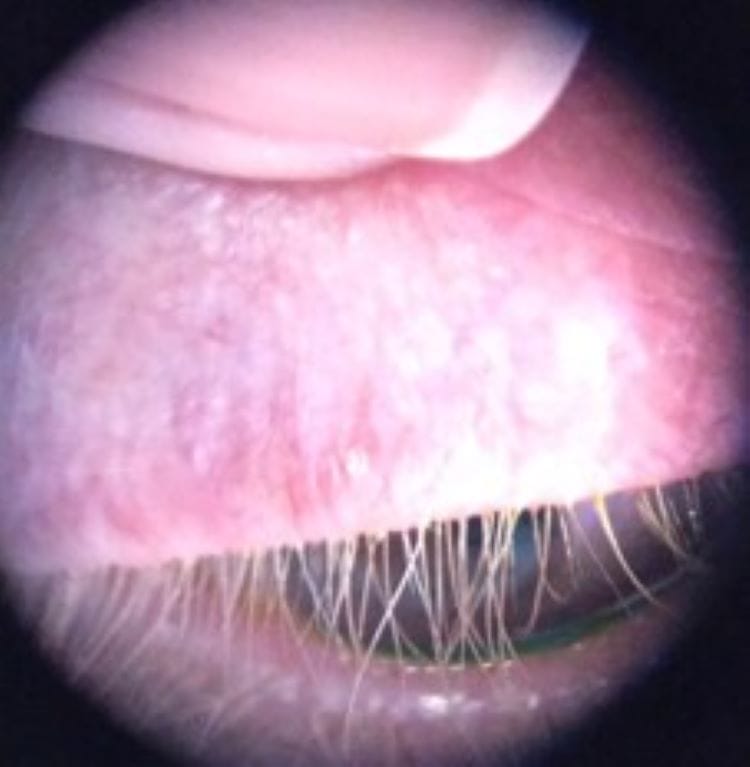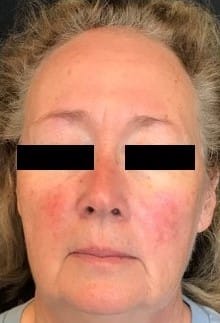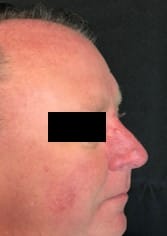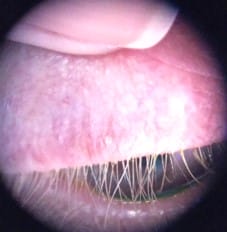Rosacea is a common skin condition that can affect the patients we encounter every day during a comprehensive eye exam. As more optometrists recognize and treat this chronic condition, it’s important to consider identification, subtypes, and ongoing management. More than half of patients identified with rosacea will have symptoms that relate to their ocular health. Patients can have dryness, photophobia, foreign-body sensation and co-morbidities such as blepharitis and keratitis that ultimately can compromise vision.1
UNDERSTANDING ROSACEA AND OCULAR ROSACEA


Rosacea is a common, chronic skin condition of which the pathophysiology and pathogenesis are poorly understood. In 2017, an updated system of classifying rosacea through phenotype has been supported worldwide and by the National Rosacea Society. It includes any two of the following: non-transient erythema, flushing, telangiectasias, edema, papules and pustules. These all make up the fixed central facial erythema phenotype.2
The second phenotype is phymatous changes, which are typically seen on the nose and are more common in men.2 Itching, burning and stinging are secondary characteristics that can also occur with rosacea.2 See Figures 1 and 2 for classic examples of patients suffering with facial and ocular rosacea.




SYMPTOMS OF ROSACEA
- Facial redness: non-transient (persistent) redness on the cheeks, nose, forehead and chin
- Flushing: intense episodes of redness or “blushing,” often triggered by spicy food, alcohol, increased temperatures, stress, caffeine and UV exposure
- Papules and Pustules: small red bumps (papules) or pus-filled lesions (pustules) often resembling acne
- Telangiectasia: those pesky visible blood vessels that show up on the surface of the skin and creep over the eyelid margins, as depicted in Figure 3


COMMON COMORBIDITIES
Demodex: While there is no study demonstrating causation of demodex and rosacea, there is a strong correlation with rosacea and demodex mites.3 Rosacea is a significant risk factor for demodex blepharitis and vice versa. One study found that demodex blepharitis had a higher prevalence in the papulopustular variety than those with erythematous telangiestasia.4 This supports what we know about Demodex folliculorum and that the mite enjoys snacking on sebum. When you see demodex blepharitis be on the lookout for rosacea, and when you see rosacea of the face, look carefully and examine eyelid margins closely for collarettes. Treat both diseases accordingly and simultaneously.
Meibomian Gland Dysfunction: Patients will often have a more recalcitrant variant of meibomian gland dysfunction, and ocular rosacea can precede facial rosacea.5 This is another reason we need to be well versed because optometrists often diagnose rosacea before other health care providers. Incorporate a SPEED questionnaire to easily identify symptoms. Push on meibomian glands diagnostically to properly evaluate their function.
TREATMENT OPTIONS FOR ROSACEA AND OCULAR ROSACEA
Treatment for rosacea and ocular rosacea aims to control symptoms, reduce the associated inflammation, and improve overall quality of life. These patients often have psychosomatic issues because of appearance. I’ve had many patients who were incredibly self conscious about how they appeared, which can also lead to depression and anxiety. While there is no cure for rosacea, there are a number of ways to effectively manage symptoms. It’s important for patients to understand the chronicity of the disease.
- Lifestyle modifications: Identify and apply trigger avoidance. Understanding what foods are likely to exacerbate rosacea is important. Spicy foods, alcohol, and caffeine can make the condition flare. A gentle skincare approach (such as a micellar water cleanser) is essential instead of harsh scrubbing and aggressive ingredients. This is right in our wheelhouse since the eyelids should be cared for as gently as possible as well. Sunscreen is paramount for all of our patients, but sunscreen is especially important for those with rosacea.
- Topical treatments: There are many topical prescription therapies that can contain brimonidine, oxymetazoline, metronidazole, azelaic acid, ivermectin, and minocycline.6
- Oral medications, such as doxycycline, minocycline, and isotretinoin are also utilized in the treatment of rosacea. Hydroxychloroquine is a recent addition to the treatment of rosacea, but larger studies are needed to evaluate the efficacy.2
- Laser and light therapy with IPL: Persistent redness, telangiectasia and edema, as well as demodicosis, can be effectively treated with IPL and a variety of lasers. Understanding each modality, the efficacy and tolerability allows us to choose the best device for the patient.7 These are procedures that can be very safe and efficacious with the proper use of eye shields, with which we are intimately familiar and should give us confidence in our abilities to properly treat patients with ocular rosacea.
Rosacea and ocular rosacea are chronic conditions that can affect the well-being of our patients, their ocular health, and ultimately their vision. The chronicity of the disease requires us to be diligent in managing patient expectations, their symptoms, as well as understanding the comorbidities that can be associated with rosacea and treating those simultaneously.
The exact cause of rosacea remains unknown, but it is very common in our patient populations. We can all educate our patients about lifestyle factors, which can be modified to include the avoidance of environmental triggers. Sunscreen can easily be adopted into daily routines. Treatment options exist that many of us utilize in our own clinics through IPL or that we can comanage with our optometric colleagues that have IPL technology.
Our patients will be more effectively managed, better educated and potentially have a better quality of life if we as optometry embrace and expand our understanding of this frustrating disease.
References
1 Van Zuuren EJ. Rosacea. N Engl J Med. 2017 Nov 2;377(18):1754-1764. doi: 10.1056/NEJMcp1506630. PMID: 29091565.
2 Zhang H, Tang K, Wang Y, Fang R, Sun Q. Rosacea Treatment: Review and Update. Dermatol Ther (Heidelb). 2021 Feb;11(1):13-24. doi: 10.1007/s13555-020-00461-0. Epub 2020 Nov 10. PMID: 33170491; PMCID: PMC7858727.
3 Gonzalez-Hinojosa D, Jaime-Villalonga A, Aguilar-Montes G, Lammoglia-Ordiales L. Demodex and rosacea: Is there a relationship? Indian J Ophthalmol. 2018 Jan;66(1):36-38. doi: 10.4103/ijo.IJO_514_17. PMID: 29283119; PMCID: PMC5778578.
4 Andreas M, Fabczak-Kubicka A, Schwartz RA. Ocular rosacea: an under-recognized entity. Ital J Dermatol Venerol. 2023 Apr;158(2):110-116. doi: 10.23736/S2784-8671.23.07484-4. PMID: 37153945.
5 Ooi KG, Watson SL. Rosacea Meibomian Gland Dysfunction Posterior Blepharitis May Be a Marker for Earlier Associated Dyslipidaemia and Inflammation Detection and Treatment with Statins. Metabolites. 2023 Jun 30;13(7):811. doi: 10.3390/metabo13070811. PMID: 37512518; PMCID: PMC10384312.
6 Van Zuuren EJ, Fedorowicz Z, Tan J, et al. Interventions for rosacea based on the phenotype approach: an updated systematic review including GRADE assessments. Br J Dermatol. 2019;181(1):65–79
7 Loyal J, Carr E, Almukhtar R, Goldman MP. Updates and Best Practices in the Management of Facial Erythema. Clin Cosmet Investig Dermatol. 2021 Jun 8;14:601-614. doi: 10.2147/CCID.S267203. PMID: 34135612; PMCID: PMC8197440.
This story was originally published in Review of Presbyopia and the Aging Eye.




